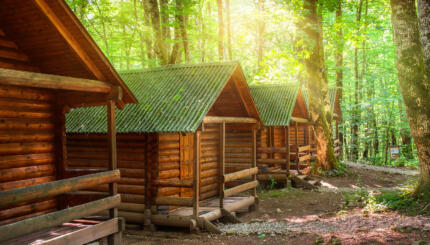Josh Levine is the director of Camp Alonim in Brandeis, CA.
One of the reasons I am delighted to be one of the regular bloggers in The Canteen is that at Camp Alonim, where I grew up and where I’ve been the director for the past three years, our canteen is a favorite spot. It’s where mail and packages are distributed each day. It’s where the campers go each night for their bedtime snacks. It’s where the boys and girls in each age group get to hang out together one more time before they wish each other a “laila tov” (good night) and go their separate ways. Mail, food, and being with friends – can you see why it’s such a popular place?
The Camp Alonim canteen, as a physical structure, is just a simple shed, really. It’s made of river-rock about four-feet high, then wood, capped by a shingled roof, with a large window built into one wall and a side door. It’s just a normal building – there’s nothing innately special about it. It’s what’s been done with it by human beings – it’s what we make of it and bring of ourselves to it – that makes it special. Its exterior design, which is best described as a groovy homage to Noah’s Ark, was painted years ago by staff members who wanted it to be kid-friendly and welcoming. The interior, which is not visible in the pictures posted here, is a dense swirl of people’s names and the years they were at camp. It’s a privilege to be old enough to get to “sign the canteen,” and it’s something which campers look forward for years. (“Why do you want to be CIT?” we ask in interviews. “Well, among other things, I want to finally sign my name in the canteen!”) Campers regularly crane their necks to locate the names of their counselors, and their counselors’ counselors. In doing so, they both feel connected to and aspire to a tradition that’s larger than themselves.
The Camp Alonim canteen is more than just a place at camp. It reflects a legacy that has been passed down from one generation to another, its timelessness magnified by its being re-created and re-fashioned by each successive iteration of camp citizens. It’s an example of something ordinary that, because of the visible and less-visible contributions of the community, has been made holy. It’s what countless individuals have called home. It’s alive. In other words, it’s Jewish.
This online canteen, as a virtual edifice, is just a simple website, really. It’s based on an HTML template and its data is hosted on servers somewhere in the cloud. Blogs can be about anything. This blog is, of course, already special because it’s about Jewish camp! But, this blog has the potential to be even more special because of the community that arises in, around, and through it – the community that can make it “camp.”
At Alonim, the canteen is a hub for mail, food, and friendship. My hope is for this online canteen to be a hub for all sorts of communication, mental nosh, and community building – in the posts themselves, in the comment threads, and perhaps beyond. “Camp” can happen in cyberspace, too – if we let it. A canteen isn’t a bad place to start.



